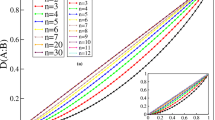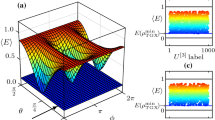Abstract
It has been proved that N-qudit (i.e., d-level subsystems) generalized W states are determined by their bipartite reduced density matrices. In this paper, we prove that only \((N-1)\) of the bipartite reduced density matrices are sufficient. Furthermore, we find that N-qudit W states preserve their determinability under stochastic local operation and classical communication (SLOCC). That is, all multipartite pure states that are SLOCC equivalent to N-qudit W states can be uniquely determined (among pure, mixed states) by their \((N-1)\) of the bipartite reduced density matrices, if the \((N-1)\) pairs of qudits constitute a tree graph on N vertices, where each pair of qudits represents an edge.
Similar content being viewed by others
References
Cramer, M., Plenio, M.B., Flammia, S.T., Somma, R., Gross, D., Bartlett, S.D., Landon-Cardinal, O., Poulin, D., Liu, Y.K.: Efficient quantum state tomography. Nat. Commun. 1, 149 (2010)
Christandl, M., Renner, R.: Reliable quantum state tomography. Phys. Rev. Lett. 109, 120403 (2012)
Ohliger, M., Nesme, V., Eisert, J.: Efficient and feasible state tomography of quantum many-body systems. New J. Phys. 15, 015024 (2013)
Schwemmer, C., Knips, L., Richart, D., Weinfurter, H., Moroder, T., Kleinmann, M., Guhne, O.: Systematic errors in current quantum state tomography tools. Phys. Rev. Lett. 114, 080403 (2015)
Lu, D.W., Xin, T., Yu, N.K., Ji, Z.F., Chen, J.X., Long, G.L., Baugh, J., Peng, X.H., Zeng, B., Laflamme, R.: Tomography is necessary for universal entanglement detection with single-copy observables. Phys. Rev. Lett. 116, 230501 (2016)
Acharya, A., Kypraios, T., Guta, M.: A comparative study of estimation methods in quantum tomography. J. Phys. A: Math. Theor. 52, 234001 (2019)
Gao, F., Qin, S.J., Huang, W., Wen, Q.Y.: Quantum private query: A new kind of practical quantum cryptographic protocol. Sci. China-Phys. Mech. Astron. 62, 070301 (2019)
Liu, B., Gao, F., Huang, W.: QKD-based quantum private query without a failure probability. Sci. China-Phys. Mech. Astron. 58, 100301 (2015)
Linden, N., Popescu, S., Wootters, W.K.: Almost every pure state of three qubits is completely determined by its two-particle reduced density matrices. Phys. Rev. Lett. 89, 207901 (2002)
Linden, N., Wootters, W.K.: The parts determine the whole in a generic pure quantum state. Phys. Rev. Lett. 89, 277906 (2002)
Diosi, L.: Three-party pure quantum states are determined by two two-party reduced states. Phys. Rev. A 70, 010302(R) (2004)
Jones, N.S., Linden, N.: Parts of quantum states. Phys. Rev. A 71, 012324 (2005)
Walck, S.N., Lyons, D.W.: Only n-qubit Greenberger-Horne-Zeilinger states are undetermined by their reduced density matrices. Phys. Rev. Lett. 100, 050501 (2008)
Chen, J.X., Dawkins, H., Ji, Z.F., Johnston, N., Kribs, D., Shultz, F., Zeng, B.: Uniqueness of quantum states compatible with given measurement results. Phys. Rev. A 88, 012109 (2013)
Xin, T., Lu, D.W., Klassen, J., Yu, N.K., Ji, Z.F., Chen, J.X., Ma, X., Long, G.L., Zeng, B., Laflamme, R.: Quantum state tomography via reduced density matrices. Phys. Rev. Lett. 118, 020401 (2017)
Wyderka, N., Huber, F., Guhne, O.: Almost all four-particle pure states are determined by their two-body marginals. Phys. Rev. A 96, 010102(R) (2017)
Huang, S.L., Chen, J.X., Li, Y.N., Zeng, B.: Quantum state tomography for generic pure states. Sci. China-Phys. Mech. Astron. 61, 110311 (2018)
Parashar, P., Rana, S.: N-qubit W states are determined by their bipartite marginals. Phys. Rev. A 80, 012319 (2009)
Rana, S., Parashar, P.: Optimal reducibility of all W states equivalent under stochastic local operations and classical communication. Phys. Rev. A 84, 052331 (2011)
Yu, N.K.: Multipartite W-type state is determined by its single-particle reduced density matrices among all W-type states. Phys. Rev. A 87, 052310 (2013)
Wu, X., Tian, G.J., Huang, W., Wen, Q.Y., Qin, S.J., Gao, F.: Determination of W states equivalent under stochastic local operations and classical communication by their bipartite reduced density matrices with tree form. Phys. Rev. A 90, 012317 (2014)
Parashar, P., Rana, S.: Reducible correlations in Dicke states. J. Phys. A: Math. Theor. 42, 462003 (2009)
Wu, X., Yang, Y.H., Wen, Q.Y., Qin, S.J., Gao, F.: Determination of Dicke states equivalent under stochastic local operations and classical communication. Phys. Rev. A 92, 052338 (2015)
Zhou, D.L.: Irreducible multiparty correlations in quantum states without maximal rank. Phys. Rev. Lett. 101, 180505 (2008)
Wu, X., Yang, Y.H., Wang, Y.K., Wen, Q.Y., Qin, S.J., Gao, F.: Determination of stabilizer states. Phys. Rev. A 92, 012305 (2015)
Martinez, D., Solis-Prosser, M.A., Canas, G., Jimenez, O., Delgado, A., Lima, G.: Experimental quantum tomography assisted by multiply symmetric states in higher dimensions. Phys. Rev. A 99, 012336 (2019)
Canas, G., Etcheverry, S., Gomez, E.S., Saavedra, C., Xavier, G.B., Lima, G., Cabello, A.: Experimental implementation of an eight-dimensional Kochen-Specker set and observation of its connection with the Greenberger-Horne-Zeilinger theorem. Phys. Rev. A 90, 012119 (2014)
Collins, D., Gisin, N., Linden, N., Massar, S., Popescu, S.: Bell inequalities for arbitrarily high-dimensional systems. Phys. Rev. Lett. 88, 040404 (2002)
Tonchev, H.S., Vitanov, N.V.: Quantum phase estimation and quantum counting with qudits. Phys. Rev. A 94, 042307 (2016)
Nikolopoulos, G.M., Ranade, K.S., Alber, G.: Error tolerance of two-basis quantum-key-distribution protocols using qudits and two-way classical communication. Phys. Rev. A 73, 032325 (2006)
Dur, W., Vidal, G., Cirac, J.I.: Three qubits can be entangled in two inequivalent ways. Phys. Rev. A 62, 062314 (2000)
Horodecki, R., Horodecki, P., Horodecki, M., Horodecki, K.: Quantum entanglement. Rev. Mod. Phys. 81, 865 (2009)
Acknowledgements
We appreciate the anonymous reviewers for their valuable suggestions. This work is supported by National Natural Science Foundation of China (Grant Nos. 61701553, 61601171, 61772134, 61802023) and the Open Foundation of State key Laboratory of Networking and Switching Technology (Beijing University of Posts and Telecommunications) (SKLNST-2016-2-10, SKLNST-2018-1-03).
Author information
Authors and Affiliations
Corresponding author
Additional information
Publisher's Note
Springer Nature remains neutral with regard to jurisdictional claims in published maps and institutional affiliations.
Appendix
Appendix
In this section, we prove for any \((s,t)\in E\) and \(i_t,j_s \ne 0\), if
then
Proof
For any \((s,t)\in E\), comparing the coefficients of \(|0_si_t\rangle \langle 0_si_t|\), \(|j_s0_t\rangle \langle j_s0_t|\) and \(|0_si_t\rangle \langle j_s0_t|\) from \(\rho _M^{st}\) and \(\rho _{SW}^{st}\), since \(i_t,j_s \ne 0\), we have
and
As \({{r}_{\left( {{i'}_{1}}\cdots {{0}_{s}}\cdots {{i}_{t}}\cdots {{i'}_{N}} \right) \left( {{i'}_{1}}\cdots {{0}_{s}}\cdots {{i}_{t}}\cdots {{i'}_{N}} \right) }}=0\), by property (ii) of positive semidefinite matrices, we can get \({{r}_{\left( {{i'}_{1}}\cdots {{0}_{s}}\cdots {{i}_{t}}\cdots {{i'}_{N}} \right) \left( {{i'}_{1}}\cdots {{j}_{s}}\cdots {{0}_{t}}\cdots {{i'}_{N}} \right) }}=0\) too. Then we can rewrite Eqs. (14), (15) and (16) as follows
and
where the sum \(\sum \limits _{{{i}_{V\backslash \{s,t\}}}\in I}\) varies over \(0,1,\ldots ,d-1\) at the \(1,\ldots ,s-1,s+1,\ldots ,t-1,t+1,\ldots ,N\) parties, excepts for \({{i'}_{1}}\cdots {{i'}_{s-1}}{{i'}_{s+1}}\cdots {{i'}_{t-1}}{{i'}_{t+1}}\cdots {{i'}_{N}}\). Therefore, from the above three equations, we can get
By the property (iii) of positive semidefinite matrices, it follows that
So we can get
After both sides of this Formula (21) is squared and subtracted, we obtain
But from Eq. (20), we obtain that the difference between the two expressions in left side of Formula (22) is \((\sum \limits _{{{i}_{V\backslash \{s,t\}}}\in I}{{{r}_{\left( {{i}_{1}}\cdots {{0}_{s}}\cdots {{i}_{t}}\cdots {{i}_{N}} \right) \left( {{i}_{1}}\cdots {{0}_{s}}\cdots {{i}_{t}}\cdots {{i}_{N}} \right) }}} ){{r}_{\left( {{{{i}'}}_{1}}\cdots {{j}_{s}}\cdots {{0}_{t}}\cdots {{{{i}'}}_{N}} \right) \left( {{{{i}'}}_{1}}\cdots {{j}_{s}}\cdots {{0}_{t}}\cdots {{{{i}'}}_{N}} \right) }}\), which is greater than or equal to 0, so we have
As \(|c_{ti}|^2 \ne 0\), we can get \({{r}_{\left( {{{{i}'}}_{1}}\cdots {{j}_{s}}\cdots {{0}_{t}}\cdots {{{{i}'}}_{N}} \right) \left( {{{{i}'}}_{1}}\cdots {{j}_{s}}\cdots {{0}_{t}}\cdots {{{{i}'}}_{N}} \right) }}=0\).
This end the proof. \(\square \)
Rights and permissions
About this article
Cite this article
Wu, X., Jia, HY., Li, DD. et al. N-qudit SLOCC equivalent W states are determined by their bipartite reduced density matrices with tree form. Quantum Inf Process 19, 423 (2020). https://doi.org/10.1007/s11128-020-02918-9
Received:
Accepted:
Published:
DOI: https://doi.org/10.1007/s11128-020-02918-9




